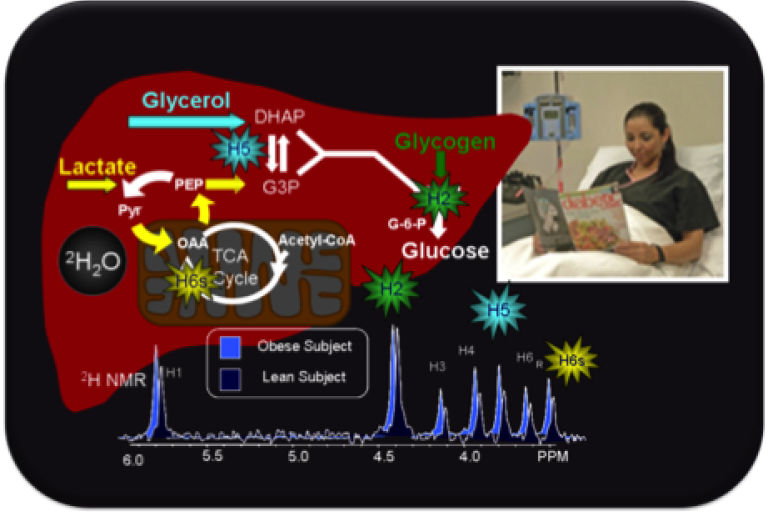
Using a deuterated-water tracer approach and NMR analysis, we and our collaborators found that obese subjects have elevated rates of gluconeogenesis from intermediates that pass through hepatic mitochondria (labeling in H6s).
Metabolic mechanisms identified in laboratory models are tested in humans using modern tracer approaches.
The Burgess lab has investigated the effects of nutrition, obesity and fatty liver disease in human subjects. Those studies have led to additional hypotheses that are being tested in laboratory models.
References
Browning JD, Baxter J, Satapati S, Burgess SC. The effect of short-term fasting on liver and skeletal muscle lipid, glucose, and energy metabolism in healthy women and men. J Lip Res. 2012;53(3):577-86. PMID: 22140269; PMCID:3276482.
Sunny NE, Parks EJ, Browning JD, Burgess SC. Excessive hepatic mitochondrial TCA cycle and gluconeogenesis in humans with nonalcoholic fatty liver disease. Cell Metab. 2011;14(6):804-10. PMID: 22152305.
Browning JD, Baker JA, Rogers T, Davis J, Satapati S, Burgess SC. Short-term weight loss and hepatic triglyceride reduction: evidence of a metabolic advantage with dietary carbohydrate restriction. Am J Clin Nutr. 2011;93(5):1048-52. PMID: 21367948.
Browning JD, Weis B, Davis J, Satapati S, Merritt M, Malloy CR, et al. Alterations in hepatic glucose and energy metabolism as a result of calorie and carbohydrate restriction. Hepatology. 2008;48(5):1487-96. PMID: 18925642.
Chevalier S, Burgess SC, Malloy CR, Gougeon R, Marliss EB, Morais JA. The greater contribution of gluconeogenesis to glucose production in obesity is related to increased whole-body protein catabolism. 2006;55(3):675-81. PMID: 16505230.
Browning JD, Davis J, Saboorian MH, Burgess SC. A low-carbohydrate diet rapidly and dramatically reduces intrahepatic triglyceride content. Hepatology. 2006;44(2):487-8. PMID: 16871586.
Weis BC, Margolis D, Burgess SC, Merritt ME, Wise H, Sherry AD, et al. Glucose production pathways by 2H and 13C NMR in patients with HIV-associated lipoatrophy. Magn Res in Med. 2004;51(4):649-54. PMID: 15065235.